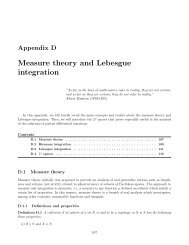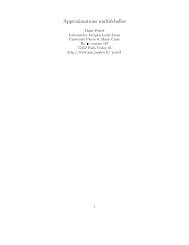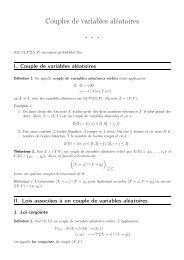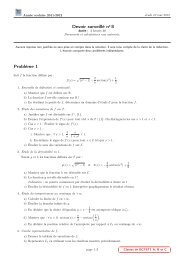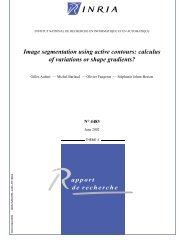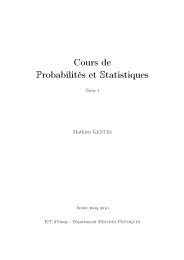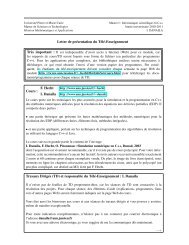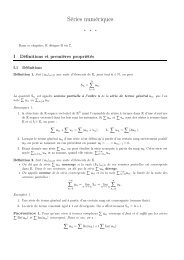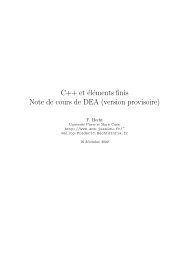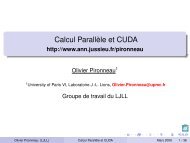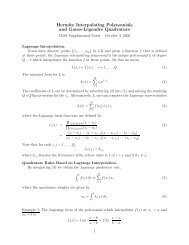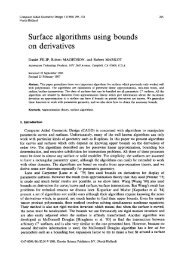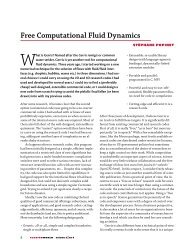Anisotropic Delaunay Mesh Adaptation for Unsteady Simulations
Anisotropic Delaunay Mesh Adaptation for Unsteady Simulations
Anisotropic Delaunay Mesh Adaptation for Unsteady Simulations
Create successful ePaper yourself
Turn your PDF publications into a flip-book with our unique Google optimized e-Paper software.
182 C. Dobrzynski and P. Frey<br />
between anisotropicelements and the anisotropyof the solution can be measured<br />
by a matching function [25].<br />
Given a metric tensor field M(x), it is natural to define critera to measure how<br />
closely the mesh elements are aligned and equidistributed with respect to M(x).<br />
For practical reasons, we introduce a single measure to evaluate the quality of<br />
an element K (given here in dimension d):<br />
〈e i ,M K e i 〉<br />
( k∑<br />
i=1<br />
Q ani (K) =α d<br />
|K| √ det(M K )<br />
where e i represents any of the k egdes of K and α d isanormalisation constant<br />
such that Q ani (K) = 1 <strong>for</strong> a regular element. Notice that Q ani ≥ 1 <strong>for</strong>all K ∈ T h<br />
and thus the larger max Q ani(K) is, the less the triangulation T h matches the<br />
K<br />
metric specifications. This quality measure is able to indicate how well a mesh<br />
element match the metric specification, both in terms of size (edge lengths) and<br />
of shape (aspect ratio).<br />
In addition, we define an efficiency index τ that provides a single scalar value<br />
to evaluate how well a mesh complies with the metric requirements:<br />
⎛<br />
⎞<br />
{<br />
∑<br />
lM (e i ) − 1if l M (e i ) < 1<br />
τ = exp ⎝ 1 ne<br />
1≤i≤ne<br />
l M (e i ) ⎠ , l M (e i )=<br />
) d<br />
,<br />
l −1<br />
M (e i) − 1<br />
and ne denotes the total number of mesh edges. The objective is to generate<br />
meshes <strong>for</strong> which the efficiency index isclose to the optimal value of one. In the<br />
simulations, a value τ ≥ 0.85 will be considered as an acceptable lower bound.<br />
else<br />
(2)<br />
2.4 Error Estimates<br />
A function e(h, u h ,f)is called an a posteriori error if it provides an upper bound<br />
on the approximation error: ‖u−u h ‖ W ≤ e(h, u h ,f). In the context of numerical<br />
simulations, the aim is toobtain an anisotropic bound where the physical derivatives<br />
are related to the size, the shape and the orientation of mesh elements. Research<br />
has been very active these recent years to develop mathematically-based<br />
error estimates and several references are provided in the bibliography section<br />
of this paper. From the numerical point of view, it is interesting toobtain estimates<br />
<strong>for</strong> the classical L 1 and L 2 norms or the H 1 seminorm. Such estimates<br />
have been provided <strong>for</strong> the interpolation error on linear Lagrange finite elements<br />
and involve the eigenvalues and eigenvectors of the Jacobian matrix of the affine<br />
mapping between the reference element and a mesh element [15, 31] or are based<br />
on the Hessian matrix of the solution [18, 1]. A local error model can be defined<br />
at a mesh vertex p as follows:<br />
e M (p) =<br />
d∑<br />
i=1<br />
h 2 i<br />
∂ 2 u<br />
∣ ∣ ,<br />
∂α 2 i



